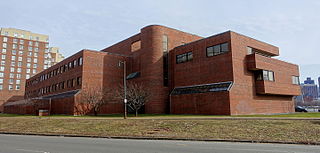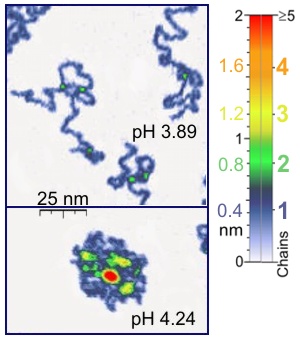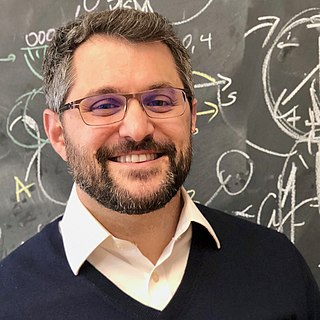Force spectroscopy is a set of techniques for the study of the interactions and the binding forces between individual molecules. These methods can be used to measure the mechanical properties of single polymer molecules or proteins, or individual chemical bonds. The name "force spectroscopy", although widely used in the scientific community, is somewhat misleading, because there is no true matter-radiation interaction.

The Rowland Institute at Harvard, formerly the Rowland Institute for Science, was founded by Edwin H. Land as a nonprofit, privately endowed basic research organization in 1980. The institute merged with Harvard University on July 1, 2002. The Rowland Institute is dedicated to experimental science across a wide range of disciplines. Research subjects at the institute includes chemistry, physics and biology, and focus on interdisciplinary work and the development of new experimental tools. It is located on the Charles River near Kendall Square in Cambridge, Massachusetts, and is a few miles away from the main campus of Harvard.

Optical tweezers are scientific instruments that use a highly focused laser beam to hold and move microscopic and sub-microscopic objects like atoms, nanoparticles and droplets, in a manner similar to tweezers. If the object is held in air or vacuum without additional support, it can be called optical levitation.

Carlos José Bustamante is a Peruvian-American scientist. He is a member of the National Academy of Sciences.
The worm-like chain (WLC) model in polymer physics is used to describe the behavior of polymers that are semi-flexible: fairly stiff with successive segments pointing in roughly the same direction, and with persistence length within a few orders of magnitude of the polymer length. The WLC model is the continuous version of the Kratky–Porod model.

Molecular motors are natural (biological) or artificial molecular machines that are the essential agents of movement in living organisms. In general terms, a motor is a device that consumes energy in one form and converts it into motion or mechanical work; for example, many protein-based molecular motors harness the chemical free energy released by the hydrolysis of ATP in order to perform mechanical work. In terms of energetic efficiency, this type of motor can be superior to currently available man-made motors. One important difference between molecular motors and macroscopic motors is that molecular motors operate in the thermal bath, an environment in which the fluctuations due to thermal noise are significant.

A single-molecule experiment is an experiment that investigates the properties of individual molecules. Single-molecule studies may be contrasted with measurements on an ensemble or bulk collection of molecules, where the individual behavior of molecules cannot be distinguished, and only average characteristics can be measured. Since many measurement techniques in biology, chemistry, and physics are not sensitive enough to observe single molecules, single-molecule fluorescence techniques caused a lot of excitement, since these supplied many new details on the measured processes that were not accessible in the past. Indeed, since the 1990s, many techniques for probing individual molecules have been developed.

Molecular biophysics is a rapidly evolving interdisciplinary area of research that combines concepts in physics, chemistry, engineering, mathematics and biology. It seeks to understand biomolecular systems and explain biological function in terms of molecular structure, structural organization, and dynamic behaviour at various levels of complexity. This discipline covers topics such as the measurement of molecular forces, molecular associations, allosteric interactions, Brownian motion, and cable theory. Additional areas of study can be found on Outline of Biophysics. The discipline has required development of specialized equipment and procedures capable of imaging and manipulating minute living structures, as well as novel experimental approaches.

Steven Chu is an American physicist and former government official. He is a Nobel laureate and was the 12th U.S. secretary of energy. He is currently the William R. Kenan Jr. Professor of Physics and Professor of Molecular and Cellular Physiology at Stanford University. He is known for his research at the University of California, Berkeley, and his research at Bell Laboratories and Stanford University regarding the cooling and trapping of atoms with laser light, for which he shared the 1997 Nobel Prize in Physics with Claude Cohen-Tannoudji and William Daniel Phillips.
Magnetic tweezers (MT) are scientific instruments for the manipulation and characterization of biomolecules or polymers. These apparatus exert forces and torques to individual molecules or groups of molecules. It can be used to measure the tensile strength or the force generated by molecules.
The Max Delbruck Prize, formerly known as the Biological physics prize, is awarded by the Division of Biological Physics of the American Physical Society, to recognize and encourage outstanding achievement in biological physics research. The prize was established in 1981, and renamed for Max Delbrück in 2006. The award consists of $10,000, an allowance for travel to the meeting where the prize is awarded, and a certificate. It was presented biennially in even-numbered years until 2014, and will be presented annually starting 2015.

In biophysics and related fields, reduced dimension forms (RDFs) are unique on-off mechanisms for random walks that generate two-state trajectories (see Fig. 1 for an example of a RDF and Fig. 2 for an example of a two-state trajectory). It has been shown that RDFs solve two-state trajectories, since only one RDF can be constructed from the data, where this property does not hold for on-off kinetic schemes, where many kinetic schemes can be constructed from a particular two-state trajectory (even from an ideal on-off trajectory). Two-state time trajectories are very common in measurements in chemistry, physics, and the biophysics of individual molecules (e.g. measurements of protein dynamics and DNA and RNA dynamics, activity of ion channels, enzyme activity, quantum dots ), thus making RDFs an important tool in the analysis of data in these fields.
Karel Svoboda is a neuroscientist. His research focuses on the question of how the neural circuits of the brain produce behavior. He has also performed notable work in molecular biophysics, neurotechnology, and neuroplasticity, particularly changes in the brain due to experience and learning. In 2021, he became the Vice President and Executive Director of the Allen Institute for Neural Dynamics.
Rae Marie Robertson-Anderson is an American biophysicist who is a Professor and Associate Provost at the University of San Diego. She works on soft matter physics and is particularly interested in the transport and molecular mechanics of biopolymer networks. Robertson-Anderson is a member of the Council on Undergraduate Research.
Polly Fordyce is an Associate Professor of Genetics and Bioengineering and fellow of the ChEM-H Institute at Stanford University. Her laboratory's research focuses on developing and applying new microfluidic platforms for quantitative, high-throughput biophysics and biochemistry and single-cell genomics.

Aleksandra Radenovic is a Swiss and Croatian biophysicist. Her research focuses on the development of experimental tools to study single-molecule biophysics. She is a professor of biological engineering at the École Polytechnique Fédérale de Lausanne (EPFL) and head of the Laboratory of Nanoscale Biology.

Joshua Shaevitz is an American biophysicist and Professor of Physics at the Lewis-Sigler Institute at Princeton University in Princeton, NJ. He is known for his work in single-molecule biophysics, bacterial growth and motility, and animal behavior.
Michelle Dong Wang is a Chinese-American physicist who is the James Gilbert White Distinguished Professor of the Physical Sciences at Cornell University. She is an Investigator of the Howard Hughes Medical Institute. Her research considers biomolecular motors and single molecule optical trapping techniques. She was appointed Fellow of the American Physical Society in 2009.
Gerd Ulrich "Uli" Nienhaus is a German physicist who is a professor and director of the Institute of Applied Physics, Karlsruhe Institute of Technology (KIT). At the KIT, he is also affiliated with the Institute of Nanotechnology, Institute of Biological and Chemical Systems, and Institute of Physical Chemistry, and he is an adjunct professor at the University of Illinois at Urbana-Champaign.
Michelle Digman is an American chemist who is an associate professor at the University of California, Irvine. She is Director of W.M. Keck Nanoimaging Lab and co-leads the Laboratory for Fluorescence Dynamics. Her research develops imaging technologies to better understand biological problems.









